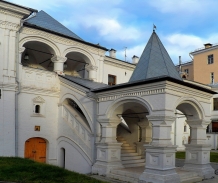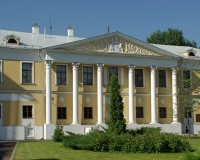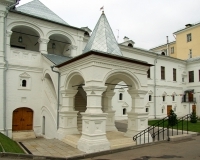Lopukhin Mansion
The mansion has been known since 1689 when it was given as a gift to Illarion Lopukhin (1637-1713) on the occasion of Peter I’s marriage to his daughter. In his estate, Lopukhin built a large stone two-story building with stone porches and a wide gate arch which connected the main courtyard with the garden. In 1697, the Lopukhins became suspected of participating in a conspiracy against Peter I and they were removed from Moscow. The Tsar’s father-in-law was sent to Totma to become a warchief. He died at a very old age and was buried in the family vault in the Church of St. Michael the Archangel in the Andronikov Monastery of the Savior in Moscow.
The mansion in Moscow became the property of Avraam, the son of its first owner. In 1697, he was sent abroad to learn shipbuilding. Upon return, he established a close relationship with his sister Tsarina Eudoxia Lopukhina who by the time had fallen into disgrace, exiled to a monastery and forcefully made a nun, and with Tsarevich Aleksey, the son of Peter I and Lopukhina. In 1718, Avraam Lopukhin was arrested for concealing the place of residence of the Tsarevich who had fled from Russia. Torture forced him to confess that he wished death to Peter I and in the same year he was executed. He was buried in the Lopukhins’ family vault in the Andronikov Monastery of the Savior.
The Lopukhins’ city estate was seized and given by Peter I to a russified merchant of Dutch origin Ivan Tames who used it as a branch of his fabric factory which was one of the largest textile companies in Russia. In 1722, the Tsar by decree granted Tames a preference to supply woolen cloth for uniform.
In 1728, Emperor Peter II decreed to return the mansion to Fyodor Lopukhin, the grandson of its first owner, and after his death it was left to his widow Vera Borisovna, the daughter of Peter I’s associate General Field Marshal Count Boris Sheremetev. The Lopukhins owned the estate until the middle of the 1770s.
In 1774 - 1775, the Lopukhin mansion was part of the Prechistensky Palace, a conglomeration of estates that had been adapted for the stay of Catherine II in Moscow on the occasion of the celebrations dedicated to the Kuchuk-Kainarji peace treaty with Turkey. The former Lopukhin mansion served as accommodation for a favorite of the Empress Adjutant General Grigory Potemkin. After the Court had moved back to St. Petersburg, the mansion was given to his mother.
Between the beginning of the 19th century and 1917, the owners of the mansion changed three times, with the last one being lady-in-waiting Maria Petrovo-Solovovo.
In 1989, public activist Svyatoslav Roerich chose the Lopukhin estate for housing the International Center of the Roerichs and the Nicholas Roerich Museum, a public organization he established. The building underwent restoration which recreated the palace façade from the 17th century. The historical fence with forged metal openwork gate wings has been also restored.
In 2015, the former Lopukhin mansion became federal property and was given to the Oriental Museum for housing its branch, the Museum of the Roerichs. 2017 saw the opening of the first exhibition of paintings by Nicholas and Svyatoslav Roerichs.




